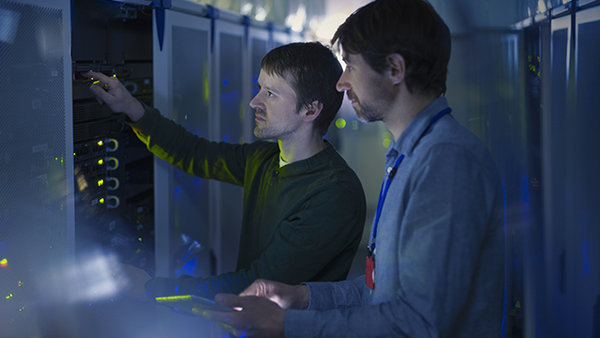Businesses continue to accelerate their digital journeys at this unique moment in time, and industry experts who successfully took on the challenge and kept businesses running certainly have insights to share on how.
One such case is how Schneider Electric CIO and SVP Elizabeth Hackenson and her team moved a diverse organization of over 110,000 global employees to work from home practically overnight.

Her team’s response to the pandemic showed the importance of accelerating to the cloud to equip employees for remote work and ensure business continuity.
To keep the Schneider Electric workforce connected, Hackenson had to triple the company’s internet bandwidth as employees went from using 20 million minutes of video calls per month to 60 million. To scale quickly, Hackenson shifted workers to the cloud from on-premise to bypass a regional edge or local edge data center, which could get bogged down and become a congestion point for employees.
“Acceleration to the cloud is happening without a doubt and companies that haven’t even put their toe in being digital and monitoring remote, they’re going to do it now,” Hackenson said. “Just look around you—our world, as we knew it, has changed rapidly. Norms are challenged, and digital resilience is redefined when we find ourselves adapting to new ways of living and working.”
Hackenson recalled that as early as January 23, 2020, at the onset of the pandemic, and Schneider Electric’s first wave of employees in Asia moved to remote working. Shortly thereafter, the rest of the global enterprise followed.
“In these instances, CIOs can choose to be either reactive or take proactive measures by preparing a solid business continuity plan. Choosing the latter may be the difference between riding the wave or being swallowed by it,” she said.
By 2025, the International Data Corporation estimated that there will be 41.6 billion connected IoT devices, including machines, sensors, and cameras. In hospitals, data centers, critical manufacturing plants, and industrial sites, continuous uptime is non-negotiable, especially during catastrophic events. How can a completely remote workforce ensure business continuity? How can both technology and people be positioned to adapt quickly?
For laying the foundation, Hackenson cited four key pillars:
1. Scale IT infrastructure.
A modernized, digital backbone and infrastructure has been the gateway to resiliency, ensuring the ability to remotely monitor and conduct critical operations throughout server rooms, data centers and manufacturing floors.
“EcoStruxure, our IoT-enabled architecture and platform, include from connected products, to managing at the edge, to apps, analytics, and services. In 2019, our portfolio grew Assets Under Management by 50%, with a 3% increase in products and over 480,000 EcoStruxure installations globally. As a digital-first organization, we extend the same ambition internally, using our own digital technologies to operate efficiently, build products, and enable digital services. Currently, we have approximately 19,000 EcoStruxure connected devices within Schneider Electric facilities to accelerate our own digital transformation,” said Hackenson.
With EcoStruxure Asset Advisors, Schneider Electric seamlessly receives data-center alerts while server rooms are vacated and manages inventory while factory-based employees remain at home.
“Today, with EcoStruxure IT, our technicians work behind the scenes to ensure business continuity and realize at least a 50% improvement in site restoration time. With this digital infrastructure foundation already laid, we can seamlessly deploy business continuity plans ensuring digital resilience.” For these plans, Hackenson listed three areas: Continuous engagement with customers to keep their priorities at the forefront, minimizing disruption to supply chain and employees, and adapting to the ever-changing normal with an augmented workforce.
2. Empower remote workers.
A Gartner, Inc. survey of CFOs revealed that 74% will move at least 5% of their previously onsite workforce to permanently remote positions post-COVID 19. How does an enterprise equip and empower its workforce remotely?
“When Schneider Electric’s entire workforce first dispersed to their homes, the enterprise was fully operational within two days. Within a week, almost all our customer care center services performed remotely to manage the 110% increase in call volumes,” recalled Hackenson.
“At the onset of the pandemic, we had roughly 30,000 concurrent connections daily. As more and more countries instituted lockdowns and work from home mandates, that number then increased to 60,000, to 90,000, and now over 100,000 today. Our marketing organization pivoted overnight to 100% digital, increasing to 115% in virtual events YoY.”
For employees to collaborate digitally, Hackenson listed digital services and platforms like Skype for Business, Microsoft Teams, and Box. “With Teams, we were easily able to scale up support for the entire workforce with minimal intervention. By the end of March, we were seeing a peak of nearly 26M minutes of virtual meetings monthly, a 73% increase since December of 2019,” she illustrated.
3. Navigate the changing market conditions.
Change is the only constant, reminded Hackenson, and enabling a seamless flow of data from suppliers to inventory management applications to instantly adjust changes in taxation or delivery date was critical in mitigating any disruption to supply and customers.
She cited an example: “We started to deploy our EcoStruxure Smart Factory program as early as 2017 to automate manufacturing and digitize our supply chain. With EcoStruxure Plant and Machine in place, our manufacturing operations could continue, even with some factory-based employees such as Planning, Logistics, Inventory and Manufacturing Engineers with remote working.”
Simplifying and harmonizing digital touchpoints to anticipate customers’ needs, working with suppliers to capitalize on their value, digitizing the supply chain—all these ensure “life is on” from the executive floor to the ecosystem of partners and people.
4. Keep cybersecurity top of mind.
There have been reports of a 400% increase in corona-related attacks with hackers developing websites, apps, and tracking tools that claim to provide real-time information about the virus. Even under normal conditions, 95% of all security incidents involve human error. The National Institute of Standards and Technology (NIST) cautioned, “Organizations should assume that malicious parties will gain control of telework client devices and attempt to recover sensitive data from them or leverage the devices to gain access to the enterprise network.”
Education and awareness are even more critical. For this, Hackenson identified the following: promoting the use of the secure VPN; enforcing the use of approved digital conferencing tools; reminding employees of secure file sharing protocols; NS mandating training completion, as well as change-in-password policies with stronger combinations.
“At Schneider Electric, we believe access to energy and digital is a basic human right. Our digital transformation started decades ago on the factory floor. For companies that may be just embarking on their journey, we can expect to see a rapid acceleration based on necessity. Technology and digitalization are the crux of what the world is reliant on today. Ensuring your enterprise is ready will help you stem the tide and set your sites on new shores. As we keep establishing new norms and capitalize on our collective digital resilience as a global community, may we all come out stronger and better together,” said Hackenson.





